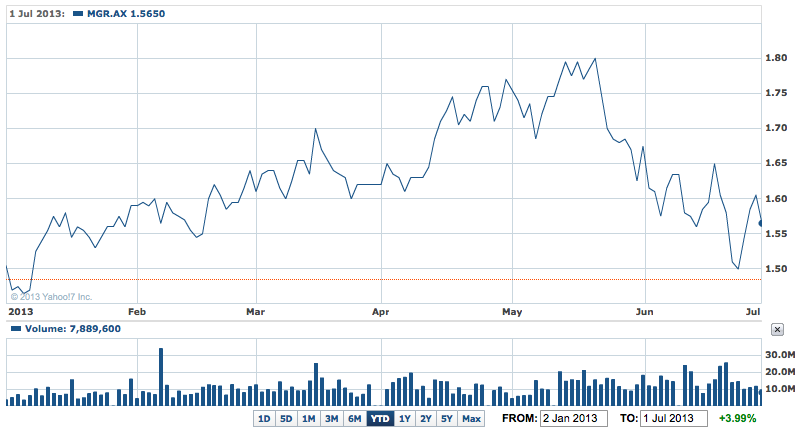A trio of big property deals worth more than $550 million were announced yesterday at the start of the new financial year.
The first saw a handy part asset sale from Mirvac (MGR) to start 2013-14 with the sale of half of its office building project at 200 George Street in Sydney’s CBD for $317 million.
The buyer was the The AMP Capital Wholesale Office Fund (an open-ended unlisted trust investing in high-quality office buildings in Australia and New Zealand) with assets of $2.8 billion at the end of 2012.
Mirvac told the ASX yesterday that the $317 million value for the land and development was based on a capitalisation rate of 6.5% and a coupon rate of 6.7% capitalised over the development period (it won’t be expensed until the building is constructed and in business).
AWOF will fund 50% of the development costs and development fees during the construction phase, while Mirvac said it will give AWOF an average 4.6-year income (rent) guarantee over any vacant space at practical completion, which is currently 26%.
On completion, the co-owners – AWOF and a wholly owned sub-trust of Mirvac Property Trust – will appoint Mirvac Asset Management as property manager under the deal.
The George Street development will comprise a 37-storey, premium grade commercial office tower of approximately 38,700 square metres.
"Following Mirvac’s purchase from AMP Capital of the original George Street asset back in 2001, AMP Capital retained a right to acquire a 50 per cent interest in the completed development. This transaction brings their interest forward and provides Mirvac with a fund through partner," Mirvac said.
The tower has been substantially pre-let to leading audit firm Ernst & Young for a term of 10 years from completion and the agreement with Mirvac lowers the risks of the purchase for AWOF investors, especially the four year rent guarantee for any unlet space.
That means Mirvac, as manager, will work hard to fill the vacant space in the building before it is completed. Mirvac shares lost 3% to end at $1.55.
MGR YTD – Mirvac agrees to deal for Sydney site

The second came from the Investa Office Fund (IOF) has paid $124.9 million for a building at 99 Walker Street in North Sydney. The seller was GE Capital of the US which has been looking to sell a ledger portfolio of properties since late 2012.
Investa said the 17,200 square metre office building would be bought using existing debt, would be generate a 7.9% yield on cost and add to the trust’s earnings in 2014. Investa said that after the deal, its gearing remained at 29%.
Investa said that after the purchase is completed, it will redevelop the ground floor retail area. The 21 levels of office accommodation is leased to seven tenants including GE Capital Finance and insurer, AAMI.
The sales came as CBRE released data showing that commercial property sales last quarter were up 24% across the country in something of a buoyant end to the financial year. Overall, the year to June saw a 12% rise in commercial transactions to $16 billion (that covers all sales of buildings, retail and industrial property above $5 million.
A third big property deal was revealed yesterday as well with industrial group, Amcor (AMC) selling a parcel land in Melbourne for $120 million.
The company sold its site on Heidelberg Road for eventual use as a large inner city residential development. $120 million.
It completes plans Amcor first announced back in 2008 to sell the property once it had moved its paper recycling business to Sydney.
The price is believed to be a record for Victoria, but at one stage Amcor had ambitions for a price of around $200 million.
The site has seen opposition from locals, planning concerns and worries about waste and dumping on the property.













